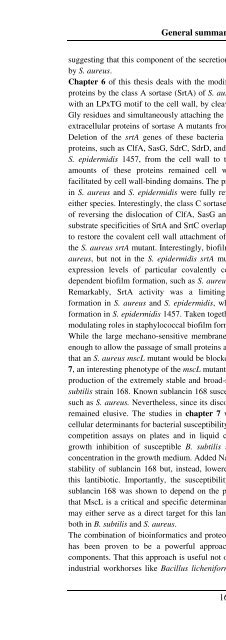The Staphylococcus aureus secretome - TI Pharma
The Staphylococcus aureus secretome - TI Pharma
The Staphylococcus aureus secretome - TI Pharma
Create successful ePaper yourself
Turn your PDF publications into a flip-book with our unique Google optimized e-Paper software.
General summary and discussion<br />
suggesting that this component of the secretion machinery is dispensable for host subversion<br />
by S. <strong>aureus</strong>.<br />
Chapter 6 of this thesis deals with the modification and processing of certain translocated<br />
proteins by the class A sortase (SrtA) of S. <strong>aureus</strong> and S. epidermidis. SrtA attaches proteins<br />
with an LPxTG motif to the cell wall, by cleaving this motif between the conserved Thr and<br />
Gly residues and simultaneously attaching the Thr residue to peptidoglycan. In this study, the<br />
extracellular proteins of sortase A mutants from S. <strong>aureus</strong> and S. epidermidis were analyzed.<br />
Deletion of the srtA genes of these bacteria resulted in the dislocation of several LPxTG<br />
proteins, such as ClfA, SasG, SdrC, SdrD, and protein A of S. <strong>aureus</strong>, and the Aap protein of<br />
S. epidermidis 1457, from the cell wall to the growth medium. Nevertheless, substantial<br />
amounts of these proteins remained cell wall-bound through non-covalent interactions<br />
facilitated by cell wall-binding domains. <strong>The</strong> protein dislocation phenotypes of srtA mutations<br />
in S. <strong>aureus</strong> and S. epidermidis were fully reversed by ectopic expression of srtA genes of<br />
either species. Interestingly, the class C sortase (SrtC) from S. epidermidis 12228 was capable<br />
of reversing the dislocation of ClfA, SasG and Aap to significant extents, showing that the<br />
substrate specificities of SrtA and SrtC overlap at least partially. By contrast, SrtC was unable<br />
to restore the covalent cell wall attachment of protein A and the SdrC and SdrD proteins in<br />
the S. <strong>aureus</strong> srtA mutant. Interestingly, biofilm formation was affected in srtA mutants of S.<br />
<strong>aureus</strong>, but not in the S. epidermidis srtA mutant. This difference can be correlated to the<br />
expression levels of particular covalently cell wall-bound proteins involved in proteindependent<br />
biofilm formation, such as S. <strong>aureus</strong> SasG and its S. epidermidis homologue Aap.<br />
Remarkably, SrtA activity was a limiting determinant for protein-dependent biofilm<br />
formation in S. <strong>aureus</strong> and S. epidermidis, whereas SrtC expression interfered with biofilm<br />
formation in S. epidermidis 1457. Taken together, these findings imply that sortases can have<br />
modulating roles in staphylococcal biofilm formation.<br />
While the large mechano-sensitive membrane channel MscL can form pores that are large<br />
enough to allow the passage of small proteins across the membrane, no evidence was obtained<br />
that an S. <strong>aureus</strong> mscL mutant would be blocked in the release of certain proteins. In chapter<br />
7, an interesting phenotype of the mscL mutant strain is however described. This relates to the<br />
production of the extremely stable and broad-spectrum lantibiotic sublancin 168 by Bacillus<br />
subtilis strain 168. Known sublancin 168 susceptible organisms include important pathogens,<br />
such as S. <strong>aureus</strong>. Nevertheless, since its discovery, the mode of action of sublancin 168 has<br />
remained elusive. <strong>The</strong> studies in chapter 7 were, therefore, aimed at the identification of<br />
cellular determinants for bacterial susceptibility towards sublancin 168. Growth inhibition and<br />
competition assays on plates and in liquid cultures revealed that sublancin 168-mediated<br />
growth inhibition of susceptible B. subtilis and S. <strong>aureus</strong> cells is affected by the NaCl<br />
concentration in the growth medium. Added NaCl did not influence the production, activity or<br />
stability of sublancin 168 but, instead, lowered the susceptibility of sensitive cells towards<br />
this lantibiotic. Importantly, the susceptibility of B. subtilis and S. <strong>aureus</strong> cells towards<br />
sublancin 168 was shown to depend on the presence of MscL. <strong>The</strong>se findings demonstrate<br />
that MscL is a critical and specific determinant in bacterial sublancin 168 susceptibility that<br />
may either serve as a direct target for this lantibiotic, or as a gate of entry to the cytoplasm<br />
both in B. subtilis and S. <strong>aureus</strong>.<br />
<strong>The</strong> combination of bioinformatics and proteomics to investigate the <strong>secretome</strong> of S. <strong>aureus</strong><br />
has been proven to be a powerful approach for dissecting the functions of <strong>secretome</strong><br />
components. That this approach is useful not only for the analyses of pathogens, but also for<br />
industrial workhorses like Bacillus licheniformis is shown in chapter 8. From the genome<br />
167













